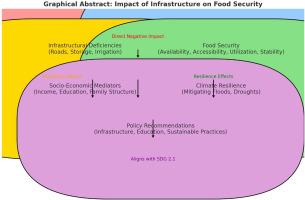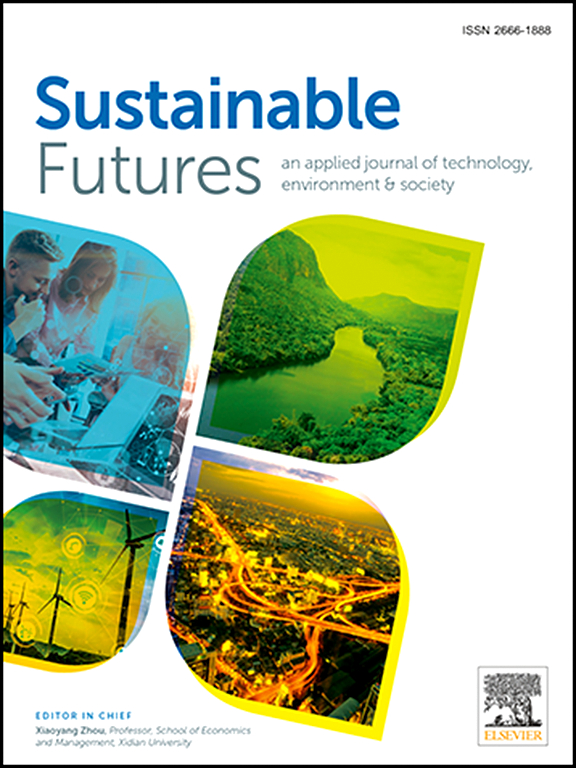基础设施、知识和气候适应能力技术加强粮食安全:来自巴基斯坦北部的证据
IF 4.9
2区 社会学
Q2 ENVIRONMENTAL SCIENCES
引用次数: 0
摘要
本研究通过横断面方法考察了基础设施不足、社会经济差距和气候脆弱性如何共同影响巴基斯坦北部托尔哈尔地区的家庭粮食安全。采用描述性统计、卡方检验、多元回归和结构方程模型对379户家庭的数据进行分析。有三个主要发现。首先,基础设施方面的差距——尤其是运输和灌溉系统方面的差距——限制了市场准入,增加了收获后的损失,从而阻碍了家庭粮食安全。其次,人力资本发挥着关键作用:受过教育的家庭采取更多气候智能型做法,而老年农民由于适应能力有限而面临更大的脆弱性。第三,结构方程模型分析表明,基础设施的改善直接提高了家庭粮食安全,并通过促进创收和灌溉渠道间接缓解了气候风险。该研究提出了一个气候基础设施-社会再生产框架,表明在以下方面进行协同投资:(1)具有气候适应性的基础设施(如防洪道路、太阳能储能),(2)连接土著知识和科学知识的数字推广服务,以及(3)对性别问题敏感的小农社会保护可以打破粮食不安全的循环。这些发现提出了一个可复制的可持续发展目标(SDG)联系模式,其中气候适应型基础设施(SDG 9)通过强化的物理系统、民主化的知识网络和交叉的社会保护这三个杠杆,将粮食安全(SDG 2)和气候行动(SDG 13)联系起来,为全球边缘化山区提供了一种模式。本文章由计算机程序翻译,如有差异,请以英文原文为准。

Infrastructure, knowledge and climate resilience technologies enhancing food security: Evidence from Northern Pakistan
This study examines how infrastructure deficits, socioeconomic disparities, and climate vulnerabilities collectively impact household food security in District Torghar, Northern Pakistan, through cross sectional approach. Data from 379 households were analyzed through descriptive statistics, chi-square test, multiple regression, and structural equation modeling. Three key findings emerge. First, infrastructural gaps – particularly in transportation and irrigation systems – impedes household food security by limiting market access and increasing post-harvest losses. Second, human capital plays a critical role: educated households adopt more climate-smart practices, while ageing farmers experience greater vulnerabilities due to limited adaptive capacity. Third, structural equation modeling analysis reveals that infrastructure improvements directly enhance household food security and indirectly mitigate climate risks by promoting income generation and irrigation access. The study advances a climate-infrastructure-social reproduction framework, demonstrating that synergistic investments in: (1) climate-resilient infrastructure (e.g., flood-proof roads, solar-powered storage), (2) digital extension services bridging indigenous and scientific knowledge, and (3) gender-sensitive social protection for gaining smallholders can break cycles of food insecurity. These findings propose a replicable Sustainable Development Goals (SDGs)-nexus model where climate-resilient infrastructure (SDG 9) bridges food security (SDG 2) and climate action (SDG 13) through three levers: hardened physical systems, democratized knowledge networks, and intersectional social protection-offering a pattern for marginalized mountainous regions worldwide.
求助全文
通过发布文献求助,成功后即可免费获取论文全文。
去求助
来源期刊

Sustainable Futures
Social Sciences-Sociology and Political Science
CiteScore
9.30
自引率
1.80%
发文量
34
审稿时长
71 days
期刊介绍:
Sustainable Futures: is a journal focused on the intersection of sustainability, environment and technology from various disciplines in social sciences, and their larger implications for corporation, government, education institutions, regions and society both at present and in the future. It provides an advanced platform for studies related to sustainability and sustainable development in society, economics, environment, and culture. The scope of the journal is broad and encourages interdisciplinary research, as well as welcoming theoretical and practical research from all methodological approaches.
 求助内容:
求助内容: 应助结果提醒方式:
应助结果提醒方式:


